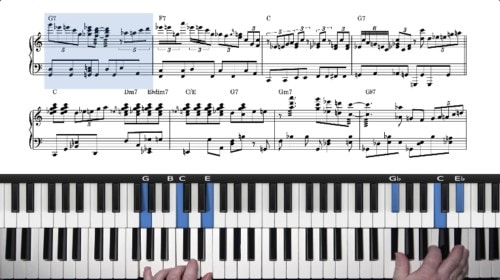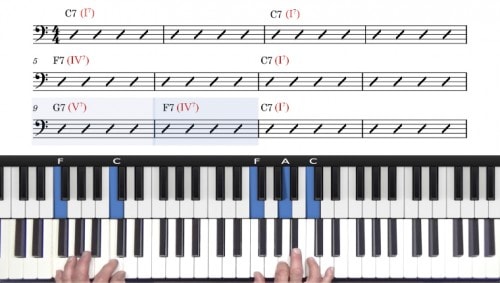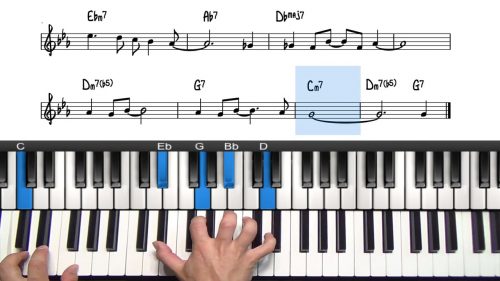Basic Blues Voicings & Patterns
In this lesson we build on the foundation we laid with the basic left hand shuffle by exploring right hand blues patterns for chording and comping. Jon talks us through the basics of the right hand and shows us some variations available for the 1, 4 and 5 chords.
Start With Basic Triads
Over the 1 chord – F7 – the most basic configuration for a comping pattern is a C triad voicing moving back and forth to an F triad inversion:

We can transpose this pattern for the other chords, i.e. for the 4 chord we have F going to Bb and for the 5 chord we have G going to C. However, we can also introduce 7th chord inversions, chord extensions, and slurred notes to add more character and interest.
Introduce The b7 & Slur The 3rd
To make this sound a little more interesting we can introduce some variations to our 1 chord. The triad example above can be used but we have the option to play more interesting notes choices:

Instead of playing the note C in the C and F chords we can change this note to a Bb. Additionally, we can slur from Eb up to E.
Chord Extensions For Extra Colour
When we go to the next chord in the progression, the 4 chord, we can transpose everything up a 4th and do the same thing. However, it can sound smoother to change the right hand voicing so that it is very similar to what we were using on the 1 chord.
Instead we can play a chord extension which introduces a jazzy flavour to our 4 chord as we are now playing a 9th voicing on the 4 chord. In the upcoming lessons we introduce chord alterations into our voicings to add even more colour and tension.
Transpose The Right Hand Chord Shapes
When we get to the 5 chord we can transpose what we were originally doing on the 1 chord to give it a new colour. This includes playing the 7th, using slurs, and we can even use our thumb to play two notes at once to fill the voicing out.

Playing symmetrical voicings can create a coherent narrative throughout the blues form but always remember that variety is key. Learn each example that Jon demonstrates in this video and apply these to your own playing.
Lesson Downloads
-
Right Hand Comping Patterns File Type: pdf
-
Comping Performance Transcriptions File Type: pdf
-
Comping Pattern Performance File Type: mp3
-
Comping Patterns Performance File Type: midi
-
Final 4 Bars Comping Pattern File Type: mp3
-
Final 4 Bars Comping Patterns File Type: midi
Practice Tips
-
Synchronisation with the left hand is critical to make these right hand figures sound good.
-
Make sure you can comfortably play the left and right hands independently before putting them together.
-
Playing along with recordings can be a great way of working on your feel.
-
Experiment with varying the amount of swing you use to play these figures. Anything from straight to a heavy swing can work if it is played with a good feel.










This website is a game changer. Life changing. Thank you so much to everyone involved.
Thanks David – I’m glad to hear you are enjoying the lessons.
Jon Cleary is hosting a seminar next week and if you have any questions with the material in this course, please submit your questions on this page and Jon will answer them live during the seminar: pianogroove.com/live-seminars/new-orleans-piano/
I hosted a slow blues seminar yesterday which you also might be interested in, you can catch the replay here: pianogroove.com/live-seminars/slow-blues-drown-in-my-own-tears/
Talk soon,
Hayden
Thanks Hayden! I’ll check those out 🙂